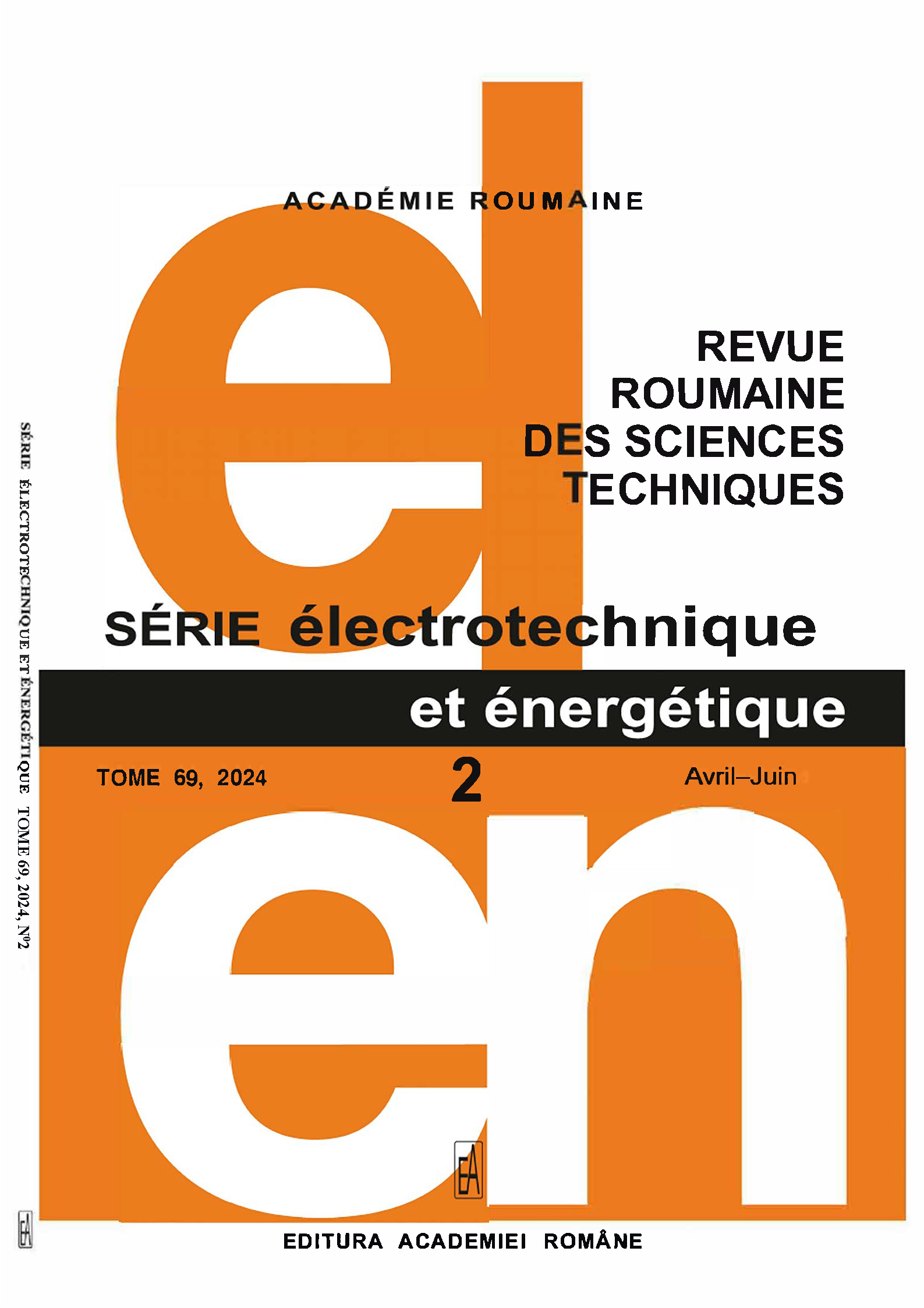UNE ÉTUDE D'EFFICACITÉ DU PHOTOVOLTAÏQUE/ÉOLIEN/BATTERIE/ÉLECTROLYSEUR/RÉSERVOIR H2/PILE À COMBUSTIBLE POUR L'ÉLECTRIFICATION D'UNE RÉGION ÉLOIGNÉE
DOI :
https://doi.org/10.59277/RRST-EE.2024.2.2Mots-clés :
Configuration optimale, Coût de l'énergie (COE), Coût actuel net total (TNPC), Algorithme d'optimisation des baleines (WOA), Systèmes de stockageRésumé
Avec le développement rapide de l’utilisation des systèmes d’énergie renouvelable, il devient de plus en plus important de combiner différentes sources dans des systèmes hybrides d’énergie renouvelable. De nombreux paramètres des systèmes hybrides d’énergie renouvelable doivent être optimisés pour dimensionner efficacement les composants du système hybride afin d’atteindre pratiquement les objectifs économiques, techniques et de conception. Cet article se concentre sur la configuration optimale des systèmes d’énergies renouvelables hybrides hors réseau (HRES). Le système se compose d'une installation photovoltaïque (PV), d'une éolienne (WT) et d'un parc de batteries (BB), d'une pile à combustible (FC) avec réservoir d'hydrogène (réservoir H2) et d'un électrolyseur (Elect). La taille optimale du composant HRES proposé est obtenue à l'aide d'une nouvelle technique méta-heuristique appelée algorithme d'optimisation des baleines (WOA). WOA améliore la configuration optimale de HRES pour produire la meilleure valeur minimale de la fonction de fitness, qui converge vers la solution optimale globale après plusieurs itérations. Le WOA proposé est utilisé pour résoudre le problème d'optimisation multi-objectif du coût de l'énergie (COE) en $/kWh et du coût actuel net total (TNPC) en $. Deux algorithmes récents, l'optimisation par essaim de particules (PSO) et l'optimiseur de loup gris (GWO), ont également été implémentés dans ce travail pour démontrer l'efficacité de l'algorithme proposé.
Références
(1) R. Fallahifar, M. Kalantar, Optimal planning of lithium-ion battery energy storage for microgrid applications: Considering capacity degradation, Journal of Energy Storage, 57, 106103 (2023).
(2) H. Deboucha, S.L. Belaid, Improved incremental conductance maximum power point tracking algorithm using fuzzy logic controller for photovoltaic system, Rev. Roum. Sci. Techn. – Électrotechn. Et Énerg., 62, pp. 381–387 (2017).
(3) S. Timur, A. Mazhar, Alternating direction method of multipliers for the optimal siting, sizing, and technology selection of Li-ion battery storage, Electric Power Systems Research, 185, pp. 150–159 (2020).
(4) A. Yahiaoui, A, Tlemçani, A comparison study of HRES for electrification of a rural city in Algeria, Wind Engineering, pp. 1–18 (2022).
(5) A. Fathima, K. Palanisamy, Optimization in microgrids with hybrid energy systems – a review, Renewable and Sustainable Energy Reviews, 45, pp. 431–446 (2015).
(6) A. Yahiaoui, K. Benmansour, M. Tadjine, Control, analysis and optimization of hybrid PV-Diesel-Battery systems for isolated rural city in Algeria, Solar Energy, 137, pp. 1–10 (2016).
(7) D. Shapiro, J. Duffy, M. Kimble, M. Pien, Solar-powered regenerative PEM electrolyzer/fuel cell system, Solar Energy, 79, pp. 544–550 (2005).
(8) S. Galli, M. Stefanoni, Development of a solar hydrogen cycle in Italy, International Journal of Hydrogen Energy, 22, pp. 453–458 (1997).
(9) B. Paul, J. Andrews, Optimal coupling of PV arrays to PEM electrolyzers in solar-hydrogen systems for remote area power supply, International Journal of Hydrogen Energy, 33, pp. 490–498 (2008).
(10) C. Li, X. Zhu, G. Cao, S. Sui, M. Hu, Dynamic modeling & sizing optimization of stand-alone photovoltaic power systems using hybrid energy storage technology, Renewable Energy, 34, pp. 815–826 (2009).
(11) M. Uzunoglu, O.C. Onar, M.S. Alam, Modeling, control and simulation of a PV/FC/UC based hybrid power generation system for stand-alone applications, Renewable Energy, 34, pp. 509–520 (2009).
(12) S.S. Deshmukh, R.F. Boehm, Review of modeling details related to renewably powered hydrogen systems, Renewable and Sustainable Energy Reviews, 12, pp. 2301–2330 (2008).
(13) A.B. Kanase-Patil, R.P. Saini, M.P. Sharma, Integrated renewable energy systems for off-grid rural electrification of remote area, Renewable Energy, 35, pp. 1342–1349 (2010).
(14) M. Laith Halabi, M. Saad, O. Lanre, J. Hazelton, Performance analysis of hybrid PV/diesel/battery system using HOMER: a case study Sabah, Malaysia, Energy Conversion and Management, 144, pp. 322–339 (2017).
(15) M. Hossain, S. Mekhilef, L. Olatomiwa, Performance evaluation of a stand-alone PV-wind-diesel-battery hybrid system feasible for a large resort center in South China Sea, Malaysia, Sustainable Cities Society, 28, pp. 358–366 (2017).
(16) L. Xu, X. Ruan, C. Mao, et al. An improved optimal sizing method for wind-solar-battery hybrid power system, IEEE Transactions on Sustainable Energy, 4, pp. 774–785 (2013).
(17) N. Gilles, D. Said, S. Ludmil, Hybrid photovoltaic/wind energy systems for remote locations, Energy Procedia, 6, pp. 666–677 (2011).
Téléchargements
Publiée
Numéro
Rubrique
Licence
(c) Copyright REVUE ROUMAINE DES SCIENCES TECHNIQUES — SÉRIE ÉLECTROTECHNIQUE ET ÉNERGÉTIQUE 2024

Ce travail est disponible sous licence Creative Commons Attribution - Pas d'Utilisation Commerciale - Pas de Modification 4.0 International.


